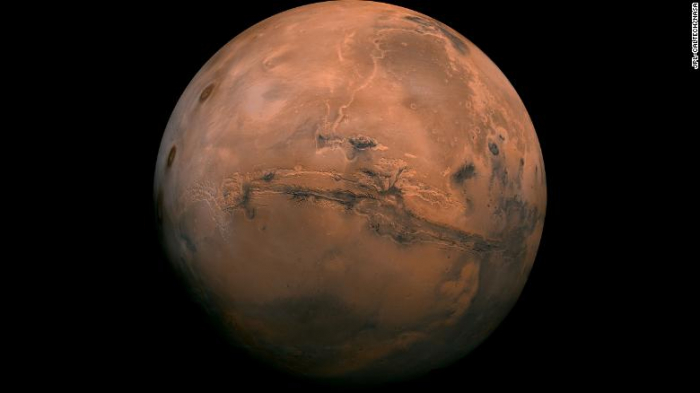So far, this sniffing has resulted in some findings that scientists are still trying to understand.
Earlier this year, the rover's tunable laser spectrometer, called SAM, which stands for Sample Analysis at Mars, detected the largest amount of methane ever measured during its mission.
SAM has also found that over time, oxygen behaves in a way that can't be explained by any chemical process scientists currently understand.
SAM has had plenty of time -- about six years -- to sniff and analyze the atmospheric composition on Mars. The data revealed that at the surface, 95% of the atmosphere is carbon dioxide, followed by 2.6% molecular nitrogen, 1.9% argon, 0.16% oxygen and 0.06% carbon monoxide.
Like Earth, Mars goes through its seasons; over the course of a year, the air pressure changes. This happens when the carbon dioxide gas freezes in winter at the poles, causing the air pressure to lower. It rises again in the spring and summer, redistributing across Mars as the carbon dioxide evaporates.
In relation to the carbon monoxide, nitrogen and argon also follow similar dips and peaks. But oxygen didn't.
Surprisingly, the oxygen actually rose by a peak increase of 30% in the spring and summer before dropping back to normal in the fall.
Given the amount of time Curiosity has been monitoring the atmosphere, it was able to detect that this pattern repeated, albeit with varying amounts of oxygen.
The variation suggests that the oxygen is being created by something, then taken away.
"The first time we saw that, it was just mind boggling," said Sushil Atreya, study author on a new paper about the oxygen levels and professor of climate and space sciences at the University of Michigan.
The study published Tuesday in the Journal of Geophysical Research: Planets.
In order to rule out errors, the scientists checked to be sure SAM was operating properly, but found no issues.
"We're struggling to explain this," said Melissa Trainer, study author and planetary scientist at NASA's Goddard Space Flight Center. "The fact that the oxygen behavior isn't perfectly repeatable every season makes us think that it's not an issue that has to do with atmospheric dynamics. It has to be some chemical source and sink (of elements into the soil) that we can't yet account for."
It relates back to the methane mystery.
The June reading indicated 21 parts per billion units by volume, or ppbv. That means of the volume of air on Mars being assessed, one billionth of the volume of air is methane.
So why is this unusually large amount of methane so interesting? On Earth, microbial life is a key source of methane. But NASA also warned that expectations of life should be managed due to the fact that interactions between rocks and water can also create methane, and Mars has water and an abundance of rocks.
"With our current measurements, we have no way of telling if the methane source is biology or geology, or even ancient or modern," said SAM Principal Investigator Paul Mahaffy of NASA's Goddard Spaceflight Center in Greenbelt, Maryland.
This isn't the first time methane has been detected on Mars by Curiosity. Over the course of its mission since landing in August 2012, Curiosity has detected methane many times and studies have been written about how the gas levels actually appear to rise and fall depending on the season. It can spike as much as 60% during the summer.
Could the two be connected to a similar chemistry since they're fluctuating the same way?
"We're beginning to see this tantalizing correlation between methane and oxygen for a good part of the Mars year," Atreya said. "I think there's something to it. I just don't have the answers yet. Nobody does."
The origin of the methane or oxygen won't be evident because the rover doesn't have any instruments that can trace or determine the source. And while both oxygen and methane can be created from biological sources, they can also arise due to chemistry, like the interaction of water and rocks.
"We have not been able to come up with one process yet that produces the amount of oxygen we need, but we think it has to be something in the surface soil that changes seasonally because there aren't enough available oxygen atoms in the atmosphere to create the behavior we see," said Timothy McConnochie, study co-author and assistant research scientist at the University of Maryland.
The scientists wanted to share their findings in the hopes that Martian experts may be able to help determine what process is creating these increases.
"This is the first time where we're seeing this interesting behavior over multiple years. We don't totally understand it," Trainer said. "For me, this is an open call to all the smart people out there who are interested in this: See what you can come up with."
CNN
















































